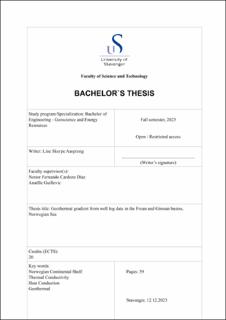| dc.contributor.advisor | Diaz, Nestor Fernando Cardozo | |
| dc.contributor.advisor | Guillevic, Anaelle Suzanne Anne | |
| dc.contributor.author | Aasprong, Line Skorpe | |
| dc.date.accessioned | 2024-03-23T16:51:19Z | |
| dc.date.available | 2024-03-23T16:51:19Z | |
| dc.date.issued | 2023 | |
| dc.identifier | no.uis:inspera:173874722:83848408 | |
| dc.identifier.uri | https://hdl.handle.net/11250/3123945 | |
| dc.description.abstract | This thesis reconstructs geothermal gradients in the Froan and Gimsan basins of the Norwegian Sea, utilizing well log data to derive a more accurate representation of the thermal regime of these basins. The study challenges the traditional linear approxima- tion of geothermal gradients, emphasizing the complexity of formation-based thermal properties and subsurface temperature regimes. By incorporating a variety of geologi- cal parameters, the study aims to deepen our understanding of subsurface temperature variations and enhance insights into the geothermal potential of these regions.
A combination of geological, geophysical, and temperature data is employed to recon- struct the geothermal gradients through a straightforward one-dimensional (1D) heat conduction model. This model, which assumes a steady-state heat flow, is used to observe the impact of thermal conductivity on the temperature regime. The primary objective is to obtain realistic thermal conductivity values from well logs, utilizing a method developed by Fuchs et al. (2015). These thermal conductivity values are then used to reconstruct the geothermal gradient in the well, assuming constant heat flow and no heat from radiogenic elements. These are of course over-simplifications, but still they allowed me to estimate the relative variation of geothermal gradient over the area.
The findings indicate significant deviations from the linear thermal gradient model, pro- viding a more realistic understanding of the variation in subsurface thermal conductivi- ties. This understanding has important implications for geothermal energy exploration, suggesting more complex thermal behavior than previously assumed. The study places greater emphasis on thermal conductivity findings over thermal gradients due to some data limitations and the inherent simplifications required in the modeling process. How- ever, the estimated thermal gradients are still worth looking, at least on a relative basis. This work highlights the need for more comprehensive data collection and advanced modeling techniques in future research to accurately assess the geothermal potential of these areas. | |
| dc.description.abstract | This thesis reconstructs geothermal gradients in the Froan and Gimsan basins of the Norwegian Sea, utilizing well log data to derive a more accurate representation of the thermal regime of these basins. The study challenges the traditional linear approxima- tion of geothermal gradients, emphasizing the complexity of formation-based thermal properties and subsurface temperature regimes. By incorporating a variety of geologi- cal parameters, the study aims to deepen our understanding of subsurface temperature variations and enhance insights into the geothermal potential of these regions.
A combination of geological, geophysical, and temperature data is employed to recon- struct the geothermal gradients through a straightforward one-dimensional (1D) heat conduction model. This model, which assumes a steady-state heat flow, is used to observe the impact of thermal conductivity on the temperature regime. The primary objective is to obtain realistic thermal conductivity values from well logs, utilizing a method developed by Fuchs et al. (2015). These thermal conductivity values are then used to reconstruct the geothermal gradient in the well, assuming constant heat flow and no heat from radiogenic elements. These are of course over-simplifications, but still they allowed me to estimate the relative variation of geothermal gradient over the area.
The findings indicate significant deviations from the linear thermal gradient model, pro- viding a more realistic understanding of the variation in subsurface thermal conductivi- ties. This understanding has important implications for geothermal energy exploration, suggesting more complex thermal behavior than previously assumed. The study places greater emphasis on thermal conductivity findings over thermal gradients due to some data limitations and the inherent simplifications required in the modeling process. How- ever, the estimated thermal gradients are still worth looking, at least on a relative basis. This work highlights the need for more comprehensive data collection and advanced modeling techniques in future research to accurately assess the geothermal potential of these areas. | |
| dc.language | eng | |
| dc.publisher | uis | |
| dc.title | Geothermal gradient from well log data in the Froan and Gimsan basins, Norwegian Sea | |
| dc.type | Bachelor thesis | |
